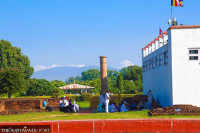Lumbini Province
Water shortage pushing Arghakhanchi residents into hardships
The villagers are hugely affected by the water crisis that starts from November and lasts till mid-June every year until the arrival of monsoon rains across the country.
Birendra KC
Bimala Baijali of Asurkot in Bhumikasthan Municipality-6, Arghakhanchi, has to struggle every dry season to manage drinking water for her family. This year, the scarcity of water has gotten worse with the decrease in the water level in the local springs.
“We have an acute shortage of drinking water in the dry season every year. It takes hours to collect even a jar of water. We can not even grow vegetables and rear animals due to the water scarcity,” said Baulaji. According to her, the water sources in her village dry up from February until June. “We have to go from one stream to another to collect a jar of water and it takes us hours.”
She and her husband had plans to start a self-sustaining agricultural venture by growing vegetables and rearing goats and cows in the village. But that plan has been put on hold for now.
“My husband decided to go abroad for employment. Two of my neighbouring families also migrated out of the village because the scarcity of water does not allow us to do anything,” Baulaji said.
Several settlements in the district have a similar problem. The local residents are hugely affected by the shortage of drinking water that generally starts from November and lasts till mid-June.
Kamala Pariyar, 59, of Budhunamara in Bhumikasthan-5 walks for an hour every day to fetch a jar of water.
“Managing water for the family is a difficult job. The springs closer to our settlements have dried up so I have to walk for one hour every day to collect water for household consumption and for domesticated animals,” said Kamala. She said she sold two goats two months ago, as it was too laborious to manage water for the cattle.
The villagers, whose main profession is farming, are unable to produce vegetables and keep domesticated animals in the dry season because of the water scarcity.
“Spinach, cauliflower and radish wither away for a lack of water. We don’t know how to support ourselves anymore,” said Pariyar.
Chhatradev is another water crisis-hit local unit in Arghakhanchi. Bishnu Prasad Bhusal of Chhatradev-3 runs a vegetable farm on a few ropanies of land that he leased near a local stream.
“I have rented land near a stream to start an agriculture farm since my settlement is crippled by a water crisis,” said Bhusal. According to him, rich families migrate to the towns and the Tarai region while the poor ones migrate towards the banks of streams due to the water crisis in the area.
In the dry season, the villagers are forced to sell their cattle and buy vegetables from the markets. According to Balaram Ghimire, an agriculture officer at the Agriculture Knowledge Centre in Arghakhanchi, around 80 percent of vegetables consumed in the district are imported from the Tarai during the dry season.
“Most settlements in the district face a shortage of water in the dry season. Vegetables cannot be grown, as the fields do not have irrigation facilities,” said Ghimire. According to him, even winter crops like wheat cannot be produced well in the district in the absence of irrigation facilities.
“It is difficult just to manage drinking water for our families, let alone grow green vegetables in our fields,” said Bimala Shrestha of Wangla. She opines that rapid population growth is the main reason behind the water scarcity in the area. “Houses used to be scattered across settlements in the past. Now, the villages are dense because of rapid population growth. So the available sources must not be enough for the increasing population.”




 16.12°C Kathmandu
16.12°C Kathmandu










